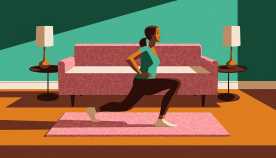AARP Hearing Center


Fall prevention should be a part of the conversation when you’re 50 and older. There are many steps you can take — both big and small — that can help you stay safer. And if you’re part of the 75 percent of Americans who want to age in place, that’s especially important. “If you make some changes, some adjustments, it's going to make you be able to be in that environment longer,” says Stephen Merrill, the Philadelphia Corporation for Aging’s health promotion nurse supervisor. “Because if you do have that bad injury, you may not be able to return to where you were or where you want to be.”
Try these 11 expert tips to make your home safer.
Light it up!
“Good lighting in general is very important in universal design,” says Paul Sullivan, founder of The Sullivan Company, a full-service residential remodeling firm based out of Massachusetts and New Hampshire that specializes in aging-in-place services.
What exactly is universal design? Simply put, it is a design concept that works for people of all ages and abilities without looking any different than traditional spaces, according to the Certified Aging-in-Place Specialist. Sullivan recommends paying particular attention to the lighting at the top of stairs and in the pathways of your home.


Dr. Emily Samuels, an assistant professor of geriatric medicine at the Icahn School of Medicine at Mount Sinai in New York, cites a 2020 study published in the journal Innovation in Aging, in which researchers found that each tenfold increase in room lighting was associated with 35 percent fewer falls in that room, regardless of visual impairment.
And what kind of lighting is best? “What they recommend is high-intensity, blue-enriched white light during the day — these are LED systems — and at nighttime, low-level automated pathway or guiding lights, like LED strips,” says Samuels, who practices as an office-based geriatric primary care physician.
Raise up your low bed
Samuels says most falls happen in the bedroom. She recommends placing your bed on risers or purchasing a higher bed frame, mattress or box spring if your bed height is not sufficiently above the crease of your knee. “If the height of the bed is too low, what happens is people oftentimes do a rocking-back-and-forth motion to gain momentum or … they bend over and lean forward to be able to stand up,” Samuels says. “And both of those have forward momentum and can cause falls.”
On a similar note, Merrill recommends taking an extra moment before slowly getting out of bed in the morning. “Sometimes when people go to stand up from sitting down, their blood pressure drops and they get dizzy,” Merrill says. “If you lift your head up off the pillow, sit on the side for a little bit; it kind of gives you that extra beat or two to know how you're feeling.”
Reassess your rugs
“Remove your loose rugs in the house,” says Merrill. “Some people — myself included — enjoy a lot of area rugs, but they can be dangerous.”
Samuels says rugs are an issue because the edges can easily become a tripping hazard. Rugs that roll or bunch up can become a tripping hazard, too, she adds. “Nonslip rug pads should be underneath all rugs, regardless of age, to decrease falls,” Samuels says. You should also try taping down the edges, she adds.
Merrill recommends using double-sided carpet tape on the edges to prevent them from moving or rolling up.
Grab a grab bar
Sullivan recommends investing in towel racks that double as grab bars for the bathroom. “Many companies now make towel bars that double as grab bars because they are made to withstand the weight and pull force of a grab bar,” he explains, adding that these towel bars should be clearly marked. Traditional towel bars can break if used as a grab bar and need to be attached in the right way with blocking (pieces of wood or metal installed between wall studs before drywall installation to provide attachment points for fixtures) in the walls, says Sullivan. "But if there isn’t any blocking where you want a grab bar, you can use a product designed for hollow walls called ‘WingIts’," he adds.
Samuels adds that “furniture surfers” who often lean on things to maintain their balance when navigating their home should consider adding grab bars throughout their house. This advice might be particularly relevant for people with adaptive devices like walkers. “What I’ve seen improve patients’ homes is to actually attach grab bars all over the walls, not just in the bathroom,” Samuels says, adding that it’s a good idea to attach them in highly trafficked areas like hallways or near stairs. “Because if their walker doesn’t fit well and they’re furniture surfing, we should make it a more stable surface.”


































































More From AARP
Older Americans Are Redefining Aging Alone
The number of older Americans living alone is growing. Here’s what to know
Property Brothers’ Tips for Older Homeowners
HGTV’s Drew and Jonathan Scott on how they set up homes for aging in place
How to Spot Home Improvement Scams
Red flags include demands for cash up front and pressure to hire them immediately